| |
“Open for me your cabinet of Patterns, and I open for you a record, which but for these half-forgotten witnesses, would have disappeared under the finger of Time. Read to me their catalogue and I read to you, in part, at least, the story of an escape from the impractical schemes of visionaries and hobbyists — a tale of national deliverance from minted evil.” — Patterson Du Bois, “The Pattern Piece,” published in the American Journal of Numismatics, January 1883
History will be made in Heritage Auction’s FUN Signature Auction when it holds its first-ever Pattern Night on Wednesday, January 7, 2009 — an extraordinary sale anchored by the incredible collection of 475 different patterns assembled by the Queller family and named “The Lemus Collection” to honor Mrs. Queller’s special collecting efforts. These wonderful pieces of numismatic history range from coins that might have been, to off-metal strikings of familiar series, to preliminary designs for collecting specialties.
|
|
| |
| |
|
|
| |
|
|
| |
| |
 |
 |
|
The silver center cent was an experimental striking intended to create a coin with an intrinsic value of one cent on a smaller copper planchet by inserting a silver plug in the center. These pieces proved impractical to produce and in the end, no one seemed to care that they were struck on smaller planchets or had a silver center.
|
|
| |
| |
|
|
| |
|
|
| |
| |
 |
 |
|
The Birch cent shares a prestigious spot in the birth of US coinage, along with the silver center cent, half disme, disme and Eagle on Globe quarter — all highly interesting and historic issues from the first year the Mint was established. Scholars debate which Birch the coin refers to as there were multiple artists named Birch working in the period.
|
|
| |
| |
|
|
| |
|
|
| |
| |
 |
 |
|
The 1794 half dime was the first coin of this denomination struck at the US Mint, because the famous 1792 issue was actually struck in John Harper's cellar before the Mint was built. Both known examples of this pattern are true die trial pieces, struck to test the half dime dies in 1794 or early 1795.
|
|
| |
| |
|
|
| |
|
|
| |
| |
 |
 |
|
It is believed that Joseph J. Mickley was responsible for the production of the few known examples of this privately struck pattern. Mickley purchased scrap dies from the Mint in the early 1860s and struck other fantasy pieces from heavily rusted and often illogical die pairings. In this case, at least the obverse and reverse are within the same series. Since they were struck in silver, there was clearly no intent to deceive.
|
|
| |
| |
|
|
| |
|
|
| |
| |
 |
 |
|
This is one of the many patterns that may have been created as “trade bait” for the recently formed Mint Cabinet, as the period 1859-60 seems to have been a heyday of such activity, which had only recently gone underground. This is strictly a fantasy piece, with “two heads and no tails.”
|
|
| |
| |
|
|
| |
|
|
| |
| |
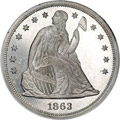 |
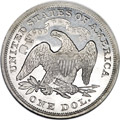 |
|
Although the motto IN GOD WE TRUST was not used on regular-issue coins until 1864, certain quarter dollars, half dollars and silver dollars dated 1863 were struck with the motto. Whether these pieces were backdated and made at a later date is not known. The entire era of the 1860s was one of many private productions for the numismatic trade.
|
|
| |
| |
|
|
| |
|
|
| |
| |
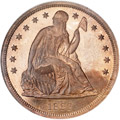 |
 |
|
A so-called transitional issue, this pattern uses the dies of the regular Seated Liberty dollar of the year, but it bears the addition of the motto IN GOD WE TRUST on a swirling scroll on the reverse, of the type introduced on regular-issue dollars in 1866.
|
|
| |
| |
|
|
| |
|
|
| |
| |
 |
 |
|
Another product of the US Mint that was likely produced some time later than the date it bears, perhaps well into the 1870s. Aluminum was an extreme rarity in 1863 and for a couple of decades after, although its rarity decreased as better ways were found to isolate the highly reactive metal from its many different naturally occurring chemical compounds.
|
|
| |
| |
|
|
| |
|
|
| |
| |
 |
 |
|
This dual-dated coin is strictly a flight of fancy that lacks a denomination of any kind. Close examination confirms the No L Indian cent die of 1864 and the Small Letters Flying Eagle cent obverse die of 1858. This piece has no doubt been viewed as something special ever since the first recorded example came to numismatic light, in an October 1868 Mason and Company sale.
|
|
| |
| |
|
|
| |
|
|
| |
| |
 |
 |
|
This coin was offered as part of an eight-coin 1870 aluminum proof set when it first surfaced in the 1970s. Although the number of 1870 aluminum proof sets struck is nowhere recorded, the few produced have nearly all been broken up in the intervening years.
|
|
| |
| |
|
|
| |
|
|
| |
| |
 |
 |
|
The series of William Barber’s Amazonian silver and gold patterns are considered among the most beautiful designs ever created for US coinage. The Amazonian gold patterns were sold in six-piece sets, mostly produced in copper. Just one set was actually produced in gold, and two sets were produced in aluminum.
|
|
| |
| |
|
|
| |
|
|
| |
| |
 |
 |
|
Anthony Paquet created this unusual design with a portrait that resembles the work of 19th-century French engravers and a robust eagle on the reverse, reminiscent of the Prussian style. Unfortunately, the dies broke extremely early in the striking process and all examples from this die feature a prominent die crack through stars 1 to 5 and extending through the date to stars 12 and 13.
|
|
| |
| |
|
|
| |
|
|
| |
| |
 |
 |
|
More patterns were made in 1877 than in any other year and the variety of half dollars produced this year is extraordinary. William Barber's distinctive obverse design was later used on the Goloid pattern dollars of 1878-1880.
|
|
| |
| |
|
|
| |
|
|
| |
| |
 |
 |
|
Fifty dollar “half union” copper patterns and their unique gold cousins are the largest denominations in the US pattern series. The denomination was apparently considered only briefly before being abandoned. Impressions from the dies were sent to Mint Director H.R. Linderman on August 30 of that year, and some have suggested that Linderman ordered the coins for his own use.
|
|
| |
| |
|
|
| |
|
|
| |
| |
 |
 |
|
William Barber prepared two obverse and one reverse die for a fifty dollar pattern gold piece which were similar to the regular double eagle. Most copper examples have been gilt to replicate the two existing gold examples, permanently housed at the Smithsonian Institution.
|
|
| |
| |
|
|
| |
|
|
| |
| |
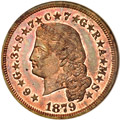 |
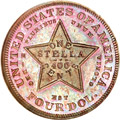 |
|
This features the same obverse design by Charles Barber as on the famous gold 1879 Flowing Hair stellas. The four dollar gold piece was an attempt to approximate the value of coins used in Europe such as the French 20 Franc, the Italian 20 Lire and the Dutch 8 Florins.
|
|
| |
| |
|
|
| |
|
|
| |
| |
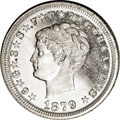 |
 |
|
Whether struck in copper, aluminum or gold, George Morgan’s Coiled Hair stella is coveted. It is difficult today to find adequate words to express how elusive pure aluminum was at the time this coin was struck. For example, the Emperor Napoleon served an imperial dinner of elaborate scale, he reserved the aluminum tableware for the most revered guests, reserving the gold service for those of lower estate.
|
|
| |
| |
|
|
| |
|
|
| |
| |
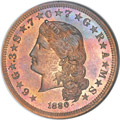 |
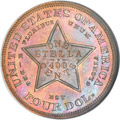 |
|
When one compares the obverse of the 1880 Flowing Hair stellas against the 1879 obverse, one notes that the date is markedly smaller and shifted, nearly touching the lowest hair curls and well separated from the denticles on the 1880 pieces, while the 1879s show a larger date, centered under the truncation, close to the denticles and the hair.
|
|
| |
| |
|
|
| |
|
|
| |
| |
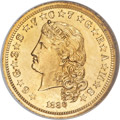 |
 |
|
The gilding on this piece was done at the Mint, and it was expertly done. It is ironic that the stella is a four dollar coin with a five-pointed star, incorporating six grams of gold and a seventh of silver and copper, to produce an international trade coin — one not quite equal to eight florins, the denominations prevailing in Austria and the Netherlands.
|
|
| |
| |
|
|
| |
|
|
| |
| |
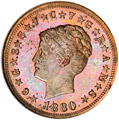 |
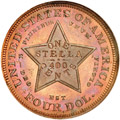 |
|
While the 1879 Flowing Hair stellas in gold are frequently seen in the numismatic marketplace, the 1880 issues are extremely rare regardless of the metal composition, be it gold, aluminum or copper. The Coiled Hair design is one of the most revered and coveted designs in all of US numismatics. Many of the copper examples have been gilt, making this non-gilt specimen particularly desirable.
|
|
| |
| |
|
|
| |
|
|
| |
| |
 |
 |
|
George T. Morgan was apparently proud enough of this design to sign it, unusual in the pattern series: His tiny initial M appears on the truncation of the neck, near the hair. Three-piece sets of the quarter, half dollar and one dollar in this design were issued in both silver and copper.
|
|
| |
| |
|
|
| |
|
|
| |
| |
 |
 |
|
The dies are the regular-issue 1885 Morgan dollar dies, but there is experimental edge lettering. It is housed in an NGC EdgeView® holder that allows easy viewing of the edge lettering. A pristine pattern with spectacular appeal and exceptional preservation.
|
|
| |
| |
|
|
| |
|
|
| |
| |
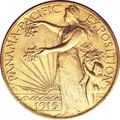 |
 |
|
The design is the same as the regular-issue 1915-S Panama-Pacific commemorative half, but it lacks the normal S mintmark and is struck in gold. These extremely rare patterns were clearly clandestine strikes. They were produced at the Philadelphia Mint before mintmark punches were applied to the working dies and are struck on cut-down Saint-Gaudens double eagle coins.
|
|
| |
| |
|
|
| |
|
|
| |
| |
 |
 |
|
1916 saw the largest group of pattern coins produced by the US Mint since the late 1870s. These patterns were produced to fine-tune already approved designs and the differences are often quiet subtle. For example, on the pattern the 1916 date is small and tightly compacted, the 1s are different and the reverse lacks the AW monogram.
|
|